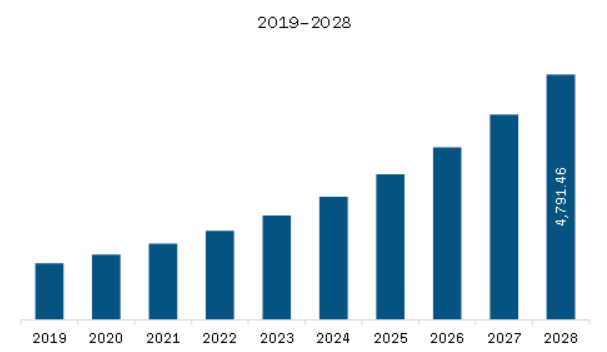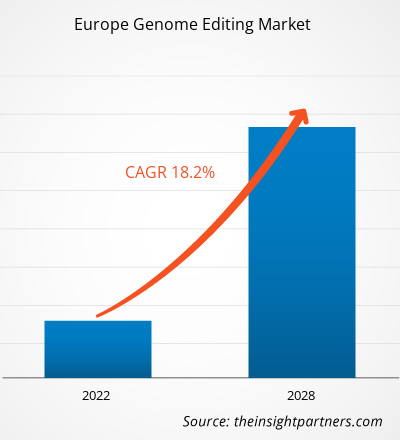The genome editing market in Europe is expected to grow from US$ 1,487.30 million in 2021 to US$ 4,791.46 million by 2028; it is estimated to grow at a CAGR of 18.2% from 2021 to 2028.
Over the past few years, advances in genome editing technologies have been making constant headlines. Genome editing technologies can alter biological research and significantly impact human health, food security, and environmental sustainability since they are precise, relatively inexpensive, easy to use, and remarkably powerful. The advances in genome editing can be traced back to quiet beginnings in the 1990s. The introduction of CRISPR-Cas9—a genome-editing tool that can be used to make precise and targeted changes in the DNA sequence with ease—is mainly responsible for the recent rise in the amount and scope of applications of genome editing technologies. The CRISPR platform's ease of use, as compared to previous technologies, has resulted in its widespread adoption and application. Genome editing could have a favorable impact on sustainable development, environmental management, food security, and the introduction of affordable diagnostics and therapies for various diseases due to these advancements. Recognizing the potential of genome editing techniques for studying and manipulating the genome, the DBT has been fostering research and innovation in genome engineering technologies and applications to make them more accessible and inexpensive for research and development (R & R&D). Through focused calls for proposals in different areas such as the development of new methods, tools, processes, and platforms for genome editing, improvement of existing genome-editing methods, and novel applications of genome editing technologies in agriculture, bioenergy, environmental research, and human health, efforts have been made to encourage R&D programs in emerging genome engineering technologies and their applications. Despite contributing to one-third of all deaths worldwide, there is no effective treatment, to date, for fibrosis. This study has established PAI-1 as a novel drug target, and pharmacologically targeting this protein may be an effective treatment for combating fibrosis. These factors for CRISPR system research are likely to favor the market's growth.
Countries in the European regions were profoundly affected due to the COVID-19 pandemic. For instance, countries such as Italy, Spain, and France have reported the highest number of positive cases and have registered the maximum number of deaths. The cell therapy instruments supply chain, which is already logistically complicated, has to face new challenges. The cell therapy instrument market has also witness some shortfall at the beginning of COVID 19 crisis owing to factors such as disruption in supply chain and demand due to lock down announced by majority of European countries. For instance, in July 2020 the UK government has allotted 100 million Euros funds to the Cell and Gene Therapy Catapult Manufacturing Innovation Centre to expedite the production of a vaccine for COVID-19 in the UK. Moreover, Stempeutics Research has filed application seeking European Commission Funding to develop cell therapy for COVID 19. The company has also entered into partnership with global consortium of cell therapy companies to gather funding for cell therapy research from European commission. Hence, Europe market is likely to show significant growth prospects during this pandemic and forecasted year.
With the new features and technologies, vendors can attract new customers and expand their footprints in emerging markets. This factor is likely to drive the Europe genome editing market. The Europe genome editing market is expected to grow at a good CAGR during the forecast period.
Europe Genome Editing Market Revenue and Forecast to 2028 (US$ Million)

- This FREE sample will include data analysis, ranging from market trends to estimates and forecasts.
- This FREE sample will include data analysis, ranging from market trends to estimates and forecasts.
Europe Genome Editing Market Segmentation
Europe Genome Editing Market – By Technology
- CRISPR
- TALEN
- Antisense
- Other
Europe Genome Editing Market – By Application
- Cell Line Engineering
- Genetic Engineering
- Diagnostic Applications
- Drug Discovery
- Others
Europe Genome Editing Market – By End User
- Pharmaceutical and Biotechnology Companies
- Academic and Research Institutes
- Clinical Research Organizations (CRO's)
Europe Genome Editing Market – By Country
- Germany
- UK
- France
- Italy
- Spain
- Rest of Europe
Europe Genome Editing Market – Companies Mentioned
- THERMO FISHER SCIENTIFIC INC.
- MERCK KGaA
- Lonza
- Horizon Discovery Group plc.
- Integrated DNA Technologies
- GenScript
- New England Biolabs
- Eurofins Scientific
- CRISPR Therapeutics
Europe Genome Editing Report Scope
| Report Attribute | Details |
|---|---|
| Market size in 2021 | US$ 1,487.30 Million |
| Market Size by 2028 | US$ 4,791.46 Million |
| Global CAGR (2021 - 2028) | 18.2% |
| Historical Data | 2019-2020 |
| Forecast period | 2022-2028 |
| Segments Covered |
By Technology
|
| Regions and Countries Covered | Europe
|
| Market leaders and key company profiles |
- Historical Analysis (2 Years), Base Year, Forecast (7 Years) with CAGR
- PEST and SWOT Analysis
- Market Size Value / Volume - Global, Regional, Country
- Industry and Competitive Landscape
- Excel Dataset



Report Coverage
Revenue forecast, Company Analysis, Industry landscape, Growth factors, and Trends

Segment Covered
Technology, and Country

Regional Scope
North America, Europe, Asia Pacific, Middle East & Africa, South & Central America

Country Scope
UK, Germany, France, Italy, Russia
Trends and growth analysis reports related to Life Sciences : READ MORE..
- THERMO FISHER SCIENTIFIC INC.
- MERCK KGaA
- Lonza
- Horizon Discovery Group plc.
- Integrated DNA Technologies
- GenScript
- New England Biolabs
- Eurofins Scientific
- CRISPR Therapeutics

 Get Free Sample For
Get Free Sample For